ACT504 Auditing Assignment: Materiality, Independence, and Controls
VerifiedAdded on 2022/10/17
|16
|4162
|20
Report
AI Summary
This report presents a comprehensive analysis of an auditing assignment, addressing key concepts such as materiality, independence, and internal controls. The report begins by examining AASB 1031 materiality, tracing its evolution and defining its significance in financial reporting. It then delves into the qualitative and quantitative guidelines of materiality, exploring the influence of audit judgment. The assignment further explores the nuances of auditor independence, differentiating between actual and perceived independence and analyzing independent situations. The report also assesses internal control weaknesses, using Everyday Supplies Pty Ltd and Retro Pty Ltd as case studies, and concludes with an audit analysis of MyPet Pty Limited. The assignment adheres to the guidelines provided in the ACT504 Auditing course, emphasizing a deep understanding of auditing principles and their practical application.
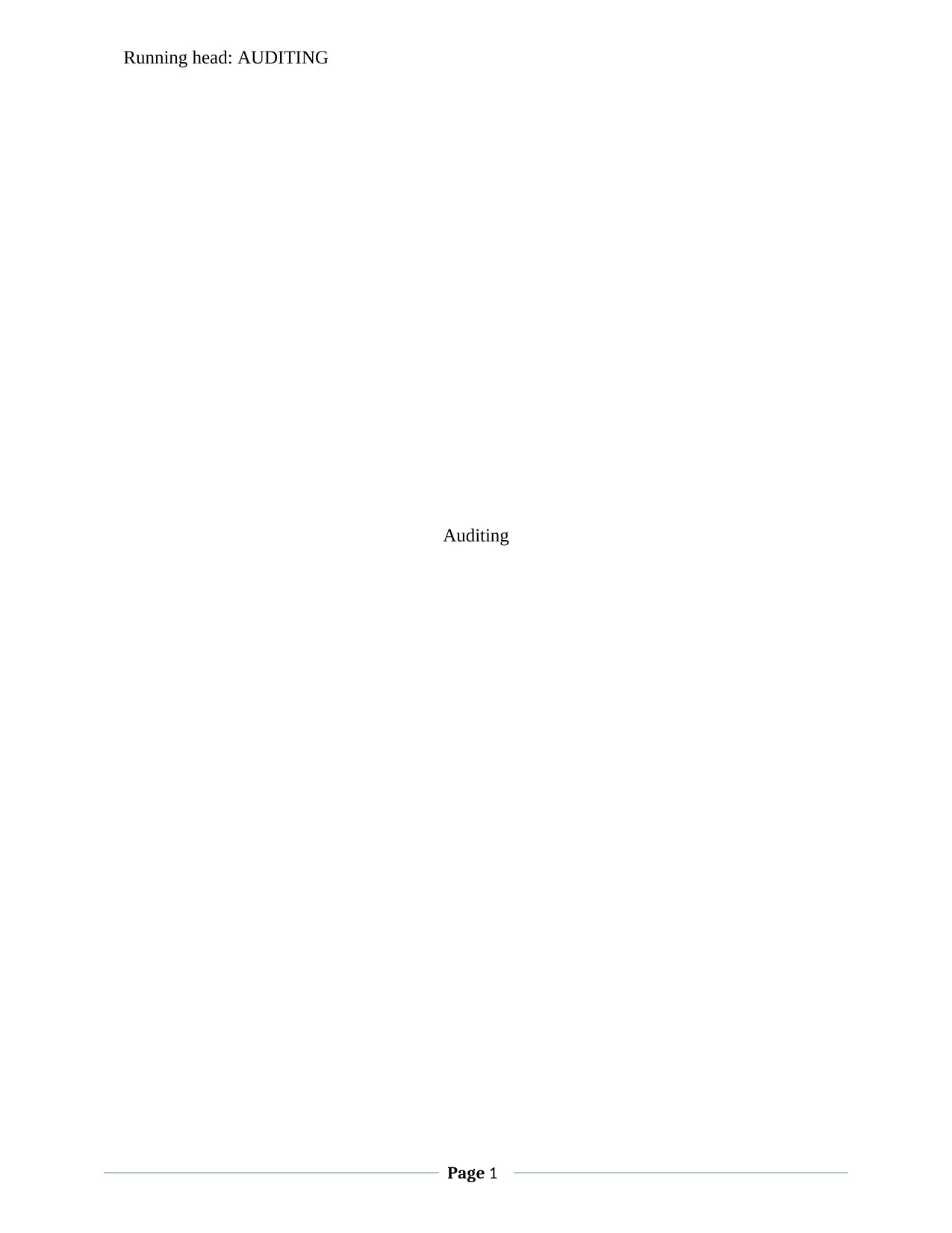
Running head: AUDITING
Auditing
Page 1
Auditing
Page 1
Paraphrase This Document
Need a fresh take? Get an instant paraphrase of this document with our AI Paraphraser
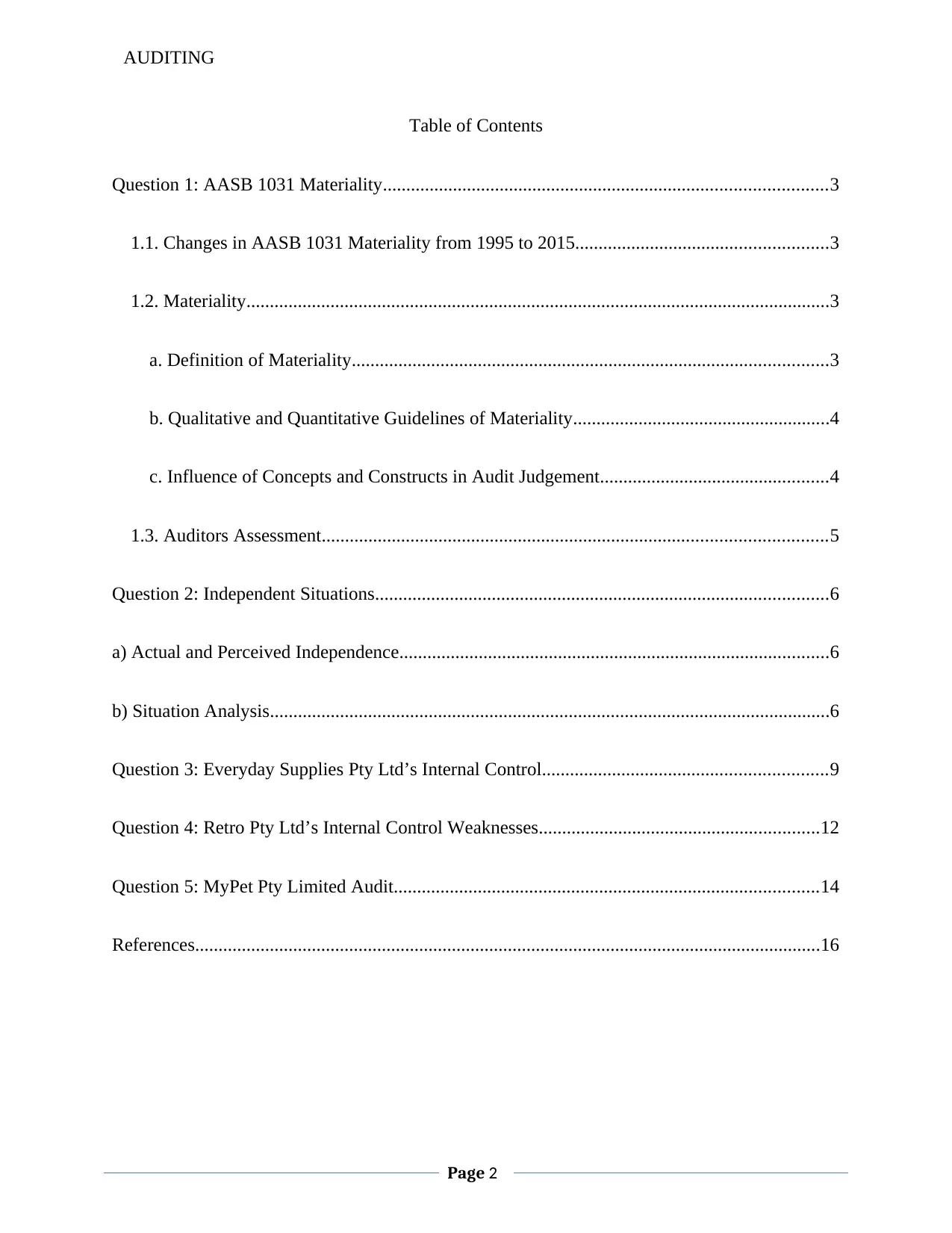
AUDITING
Table of Contents
Question 1: AASB 1031 Materiality...............................................................................................3
1.1. Changes in AASB 1031 Materiality from 1995 to 2015......................................................3
1.2. Materiality.............................................................................................................................3
a. Definition of Materiality......................................................................................................3
b. Qualitative and Quantitative Guidelines of Materiality.......................................................4
c. Influence of Concepts and Constructs in Audit Judgement.................................................4
1.3. Auditors Assessment............................................................................................................5
Question 2: Independent Situations.................................................................................................6
a) Actual and Perceived Independence............................................................................................6
b) Situation Analysis........................................................................................................................6
Question 3: Everyday Supplies Pty Ltd’s Internal Control.............................................................9
Question 4: Retro Pty Ltd’s Internal Control Weaknesses............................................................12
Question 5: MyPet Pty Limited Audit...........................................................................................14
References......................................................................................................................................16
Page 2
Table of Contents
Question 1: AASB 1031 Materiality...............................................................................................3
1.1. Changes in AASB 1031 Materiality from 1995 to 2015......................................................3
1.2. Materiality.............................................................................................................................3
a. Definition of Materiality......................................................................................................3
b. Qualitative and Quantitative Guidelines of Materiality.......................................................4
c. Influence of Concepts and Constructs in Audit Judgement.................................................4
1.3. Auditors Assessment............................................................................................................5
Question 2: Independent Situations.................................................................................................6
a) Actual and Perceived Independence............................................................................................6
b) Situation Analysis........................................................................................................................6
Question 3: Everyday Supplies Pty Ltd’s Internal Control.............................................................9
Question 4: Retro Pty Ltd’s Internal Control Weaknesses............................................................12
Question 5: MyPet Pty Limited Audit...........................................................................................14
References......................................................................................................................................16
Page 2
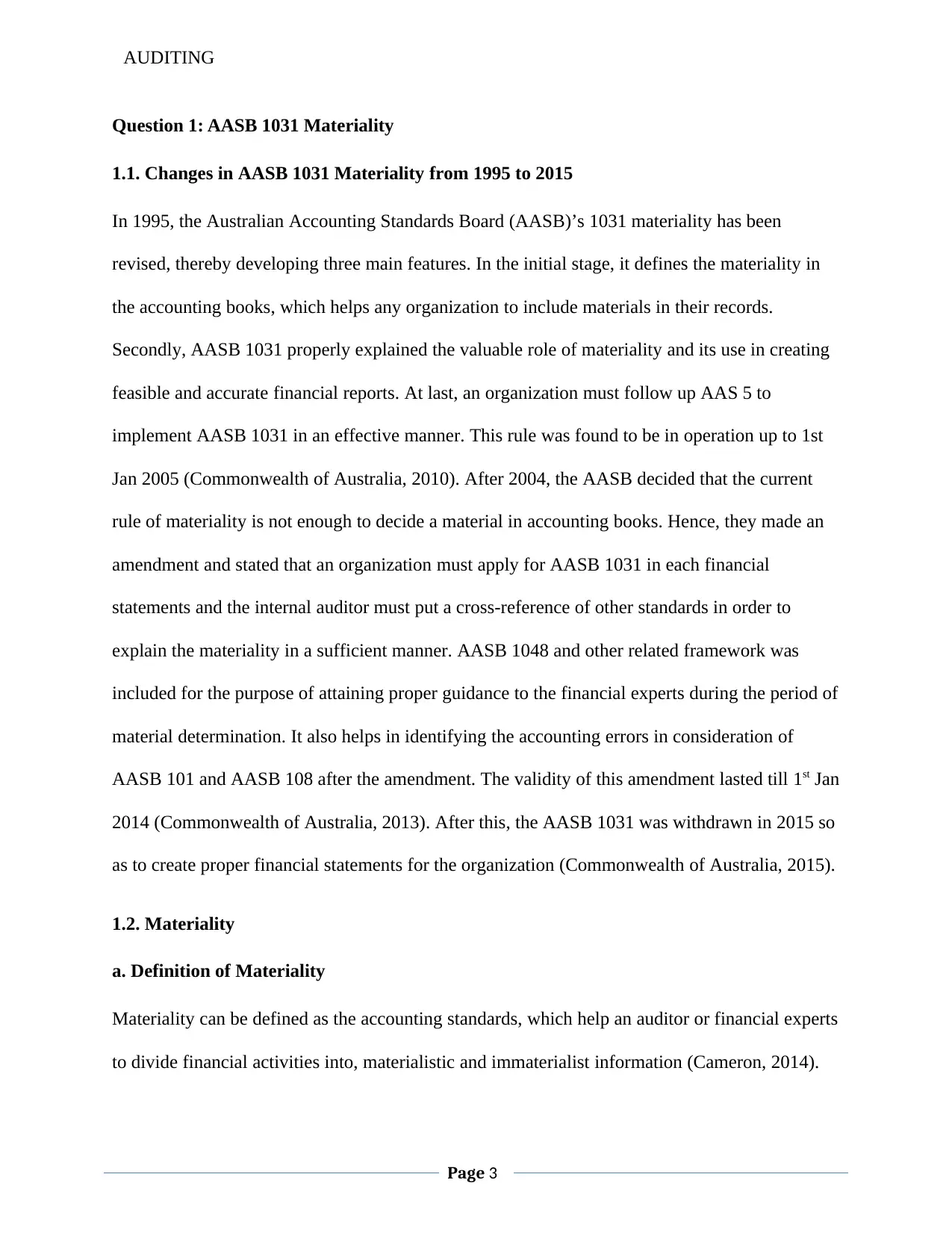
AUDITING
Question 1: AASB 1031 Materiality
1.1. Changes in AASB 1031 Materiality from 1995 to 2015
In 1995, the Australian Accounting Standards Board (AASB)’s 1031 materiality has been
revised, thereby developing three main features. In the initial stage, it defines the materiality in
the accounting books, which helps any organization to include materials in their records.
Secondly, AASB 1031 properly explained the valuable role of materiality and its use in creating
feasible and accurate financial reports. At last, an organization must follow up AAS 5 to
implement AASB 1031 in an effective manner. This rule was found to be in operation up to 1st
Jan 2005 (Commonwealth of Australia, 2010). After 2004, the AASB decided that the current
rule of materiality is not enough to decide a material in accounting books. Hence, they made an
amendment and stated that an organization must apply for AASB 1031 in each financial
statements and the internal auditor must put a cross-reference of other standards in order to
explain the materiality in a sufficient manner. AASB 1048 and other related framework was
included for the purpose of attaining proper guidance to the financial experts during the period of
material determination. It also helps in identifying the accounting errors in consideration of
AASB 101 and AASB 108 after the amendment. The validity of this amendment lasted till 1st Jan
2014 (Commonwealth of Australia, 2013). After this, the AASB 1031 was withdrawn in 2015 so
as to create proper financial statements for the organization (Commonwealth of Australia, 2015).
1.2. Materiality
a. Definition of Materiality
Materiality can be defined as the accounting standards, which help an auditor or financial experts
to divide financial activities into, materialistic and immaterialist information (Cameron, 2014).
Page 3
Question 1: AASB 1031 Materiality
1.1. Changes in AASB 1031 Materiality from 1995 to 2015
In 1995, the Australian Accounting Standards Board (AASB)’s 1031 materiality has been
revised, thereby developing three main features. In the initial stage, it defines the materiality in
the accounting books, which helps any organization to include materials in their records.
Secondly, AASB 1031 properly explained the valuable role of materiality and its use in creating
feasible and accurate financial reports. At last, an organization must follow up AAS 5 to
implement AASB 1031 in an effective manner. This rule was found to be in operation up to 1st
Jan 2005 (Commonwealth of Australia, 2010). After 2004, the AASB decided that the current
rule of materiality is not enough to decide a material in accounting books. Hence, they made an
amendment and stated that an organization must apply for AASB 1031 in each financial
statements and the internal auditor must put a cross-reference of other standards in order to
explain the materiality in a sufficient manner. AASB 1048 and other related framework was
included for the purpose of attaining proper guidance to the financial experts during the period of
material determination. It also helps in identifying the accounting errors in consideration of
AASB 101 and AASB 108 after the amendment. The validity of this amendment lasted till 1st Jan
2014 (Commonwealth of Australia, 2013). After this, the AASB 1031 was withdrawn in 2015 so
as to create proper financial statements for the organization (Commonwealth of Australia, 2015).
1.2. Materiality
a. Definition of Materiality
Materiality can be defined as the accounting standards, which help an auditor or financial experts
to divide financial activities into, materialistic and immaterialist information (Cameron, 2014).
Page 3
⊘ This is a preview!⊘
Do you want full access?
Subscribe today to unlock all pages.

Trusted by 1+ million students worldwide
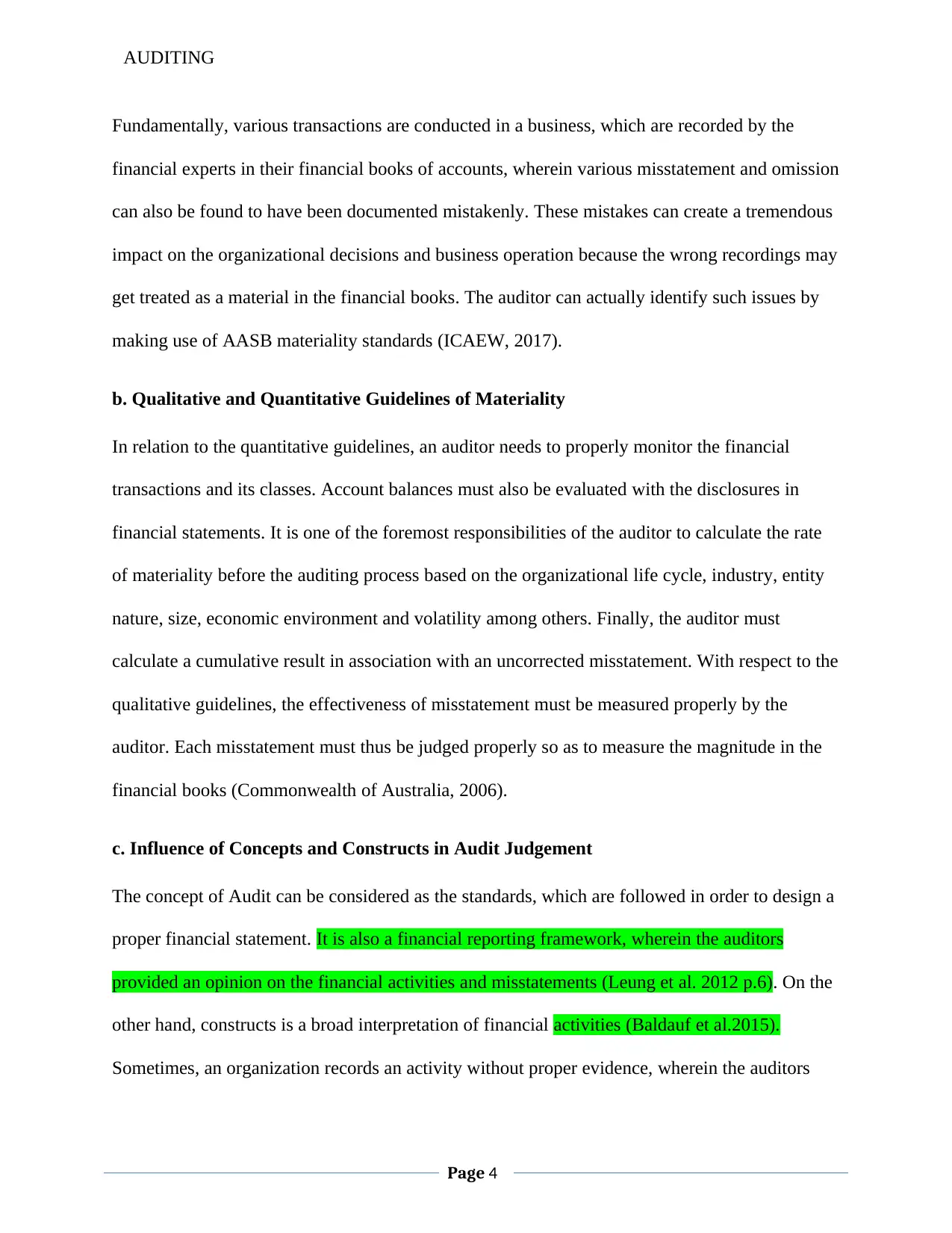
AUDITING
Fundamentally, various transactions are conducted in a business, which are recorded by the
financial experts in their financial books of accounts, wherein various misstatement and omission
can also be found to have been documented mistakenly. These mistakes can create a tremendous
impact on the organizational decisions and business operation because the wrong recordings may
get treated as a material in the financial books. The auditor can actually identify such issues by
making use of AASB materiality standards (ICAEW, 2017).
b. Qualitative and Quantitative Guidelines of Materiality
In relation to the quantitative guidelines, an auditor needs to properly monitor the financial
transactions and its classes. Account balances must also be evaluated with the disclosures in
financial statements. It is one of the foremost responsibilities of the auditor to calculate the rate
of materiality before the auditing process based on the organizational life cycle, industry, entity
nature, size, economic environment and volatility among others. Finally, the auditor must
calculate a cumulative result in association with an uncorrected misstatement. With respect to the
qualitative guidelines, the effectiveness of misstatement must be measured properly by the
auditor. Each misstatement must thus be judged properly so as to measure the magnitude in the
financial books (Commonwealth of Australia, 2006).
c. Influence of Concepts and Constructs in Audit Judgement
The concept of Audit can be considered as the standards, which are followed in order to design a
proper financial statement. It is also a financial reporting framework, wherein the auditors
provided an opinion on the financial activities and misstatements (Leung et al. 2012 p.6). On the
other hand, constructs is a broad interpretation of financial activities (Baldauf et al.2015).
Sometimes, an organization records an activity without proper evidence, wherein the auditors
Page 4
Fundamentally, various transactions are conducted in a business, which are recorded by the
financial experts in their financial books of accounts, wherein various misstatement and omission
can also be found to have been documented mistakenly. These mistakes can create a tremendous
impact on the organizational decisions and business operation because the wrong recordings may
get treated as a material in the financial books. The auditor can actually identify such issues by
making use of AASB materiality standards (ICAEW, 2017).
b. Qualitative and Quantitative Guidelines of Materiality
In relation to the quantitative guidelines, an auditor needs to properly monitor the financial
transactions and its classes. Account balances must also be evaluated with the disclosures in
financial statements. It is one of the foremost responsibilities of the auditor to calculate the rate
of materiality before the auditing process based on the organizational life cycle, industry, entity
nature, size, economic environment and volatility among others. Finally, the auditor must
calculate a cumulative result in association with an uncorrected misstatement. With respect to the
qualitative guidelines, the effectiveness of misstatement must be measured properly by the
auditor. Each misstatement must thus be judged properly so as to measure the magnitude in the
financial books (Commonwealth of Australia, 2006).
c. Influence of Concepts and Constructs in Audit Judgement
The concept of Audit can be considered as the standards, which are followed in order to design a
proper financial statement. It is also a financial reporting framework, wherein the auditors
provided an opinion on the financial activities and misstatements (Leung et al. 2012 p.6). On the
other hand, constructs is a broad interpretation of financial activities (Baldauf et al.2015).
Sometimes, an organization records an activity without proper evidence, wherein the auditors
Page 4
Paraphrase This Document
Need a fresh take? Get an instant paraphrase of this document with our AI Paraphraser
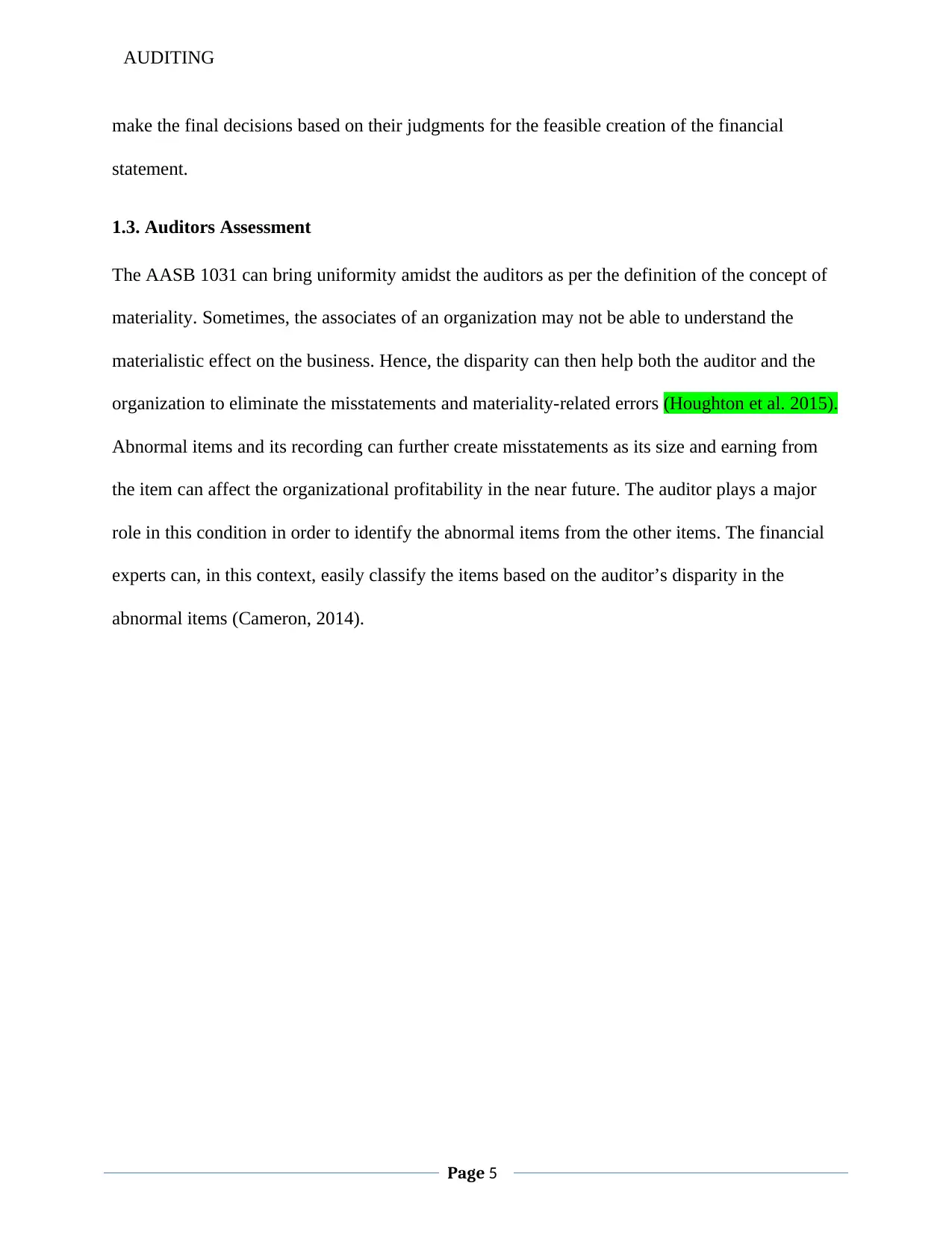
AUDITING
make the final decisions based on their judgments for the feasible creation of the financial
statement.
1.3. Auditors Assessment
The AASB 1031 can bring uniformity amidst the auditors as per the definition of the concept of
materiality. Sometimes, the associates of an organization may not be able to understand the
materialistic effect on the business. Hence, the disparity can then help both the auditor and the
organization to eliminate the misstatements and materiality-related errors (Houghton et al. 2015).
Abnormal items and its recording can further create misstatements as its size and earning from
the item can affect the organizational profitability in the near future. The auditor plays a major
role in this condition in order to identify the abnormal items from the other items. The financial
experts can, in this context, easily classify the items based on the auditor’s disparity in the
abnormal items (Cameron, 2014).
Page 5
make the final decisions based on their judgments for the feasible creation of the financial
statement.
1.3. Auditors Assessment
The AASB 1031 can bring uniformity amidst the auditors as per the definition of the concept of
materiality. Sometimes, the associates of an organization may not be able to understand the
materialistic effect on the business. Hence, the disparity can then help both the auditor and the
organization to eliminate the misstatements and materiality-related errors (Houghton et al. 2015).
Abnormal items and its recording can further create misstatements as its size and earning from
the item can affect the organizational profitability in the near future. The auditor plays a major
role in this condition in order to identify the abnormal items from the other items. The financial
experts can, in this context, easily classify the items based on the auditor’s disparity in the
abnormal items (Cameron, 2014).
Page 5
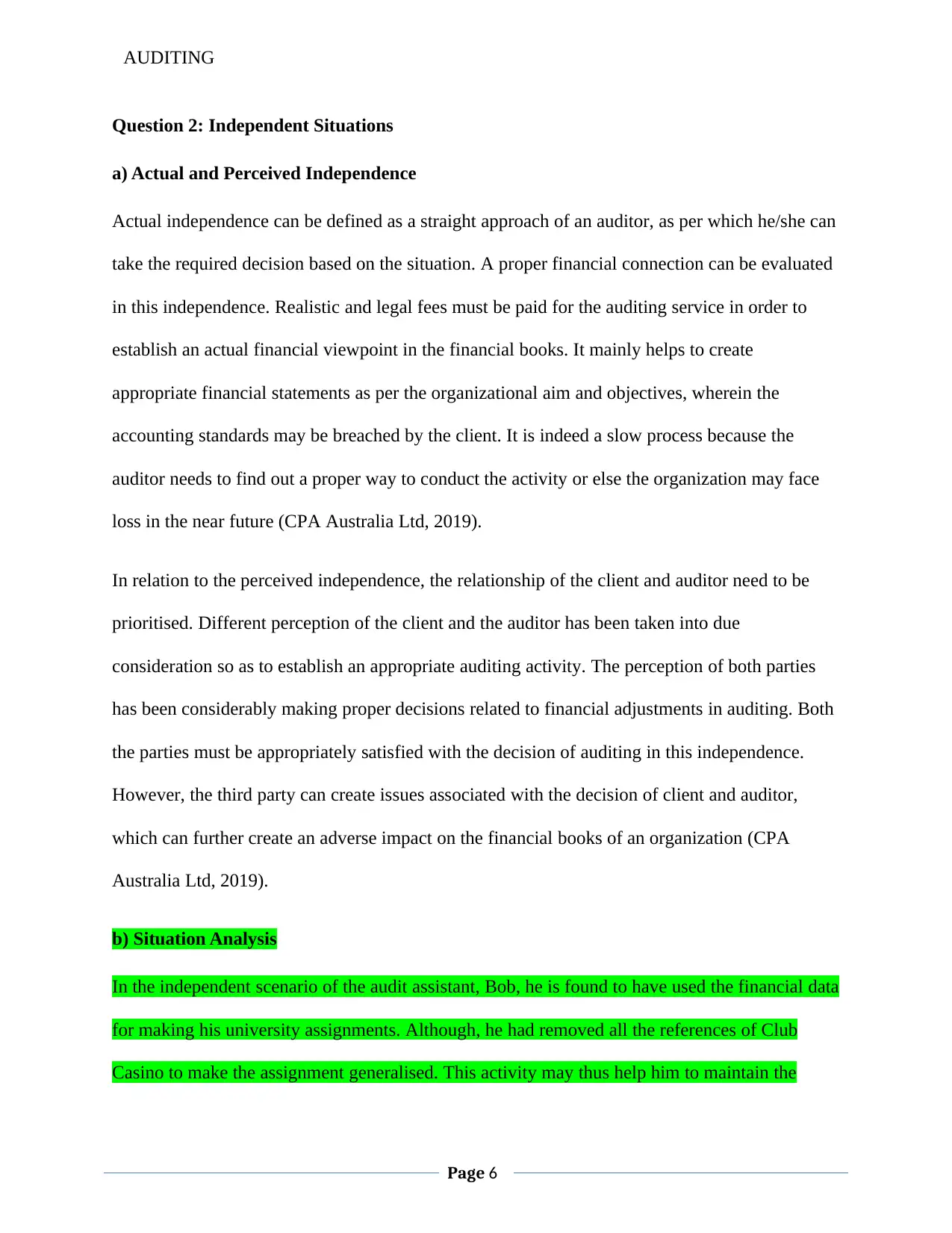
AUDITING
Question 2: Independent Situations
a) Actual and Perceived Independence
Actual independence can be defined as a straight approach of an auditor, as per which he/she can
take the required decision based on the situation. A proper financial connection can be evaluated
in this independence. Realistic and legal fees must be paid for the auditing service in order to
establish an actual financial viewpoint in the financial books. It mainly helps to create
appropriate financial statements as per the organizational aim and objectives, wherein the
accounting standards may be breached by the client. It is indeed a slow process because the
auditor needs to find out a proper way to conduct the activity or else the organization may face
loss in the near future (CPA Australia Ltd, 2019).
In relation to the perceived independence, the relationship of the client and auditor need to be
prioritised. Different perception of the client and the auditor has been taken into due
consideration so as to establish an appropriate auditing activity. The perception of both parties
has been considerably making proper decisions related to financial adjustments in auditing. Both
the parties must be appropriately satisfied with the decision of auditing in this independence.
However, the third party can create issues associated with the decision of client and auditor,
which can further create an adverse impact on the financial books of an organization (CPA
Australia Ltd, 2019).
b) Situation Analysis
In the independent scenario of the audit assistant, Bob, he is found to have used the financial data
for making his university assignments. Although, he had removed all the references of Club
Casino to make the assignment generalised. This activity may thus help him to maintain the
Page 6
Question 2: Independent Situations
a) Actual and Perceived Independence
Actual independence can be defined as a straight approach of an auditor, as per which he/she can
take the required decision based on the situation. A proper financial connection can be evaluated
in this independence. Realistic and legal fees must be paid for the auditing service in order to
establish an actual financial viewpoint in the financial books. It mainly helps to create
appropriate financial statements as per the organizational aim and objectives, wherein the
accounting standards may be breached by the client. It is indeed a slow process because the
auditor needs to find out a proper way to conduct the activity or else the organization may face
loss in the near future (CPA Australia Ltd, 2019).
In relation to the perceived independence, the relationship of the client and auditor need to be
prioritised. Different perception of the client and the auditor has been taken into due
consideration so as to establish an appropriate auditing activity. The perception of both parties
has been considerably making proper decisions related to financial adjustments in auditing. Both
the parties must be appropriately satisfied with the decision of auditing in this independence.
However, the third party can create issues associated with the decision of client and auditor,
which can further create an adverse impact on the financial books of an organization (CPA
Australia Ltd, 2019).
b) Situation Analysis
In the independent scenario of the audit assistant, Bob, he is found to have used the financial data
for making his university assignments. Although, he had removed all the references of Club
Casino to make the assignment generalised. This activity may thus help him to maintain the
Page 6
⊘ This is a preview!⊘
Do you want full access?
Subscribe today to unlock all pages.

Trusted by 1+ million students worldwide
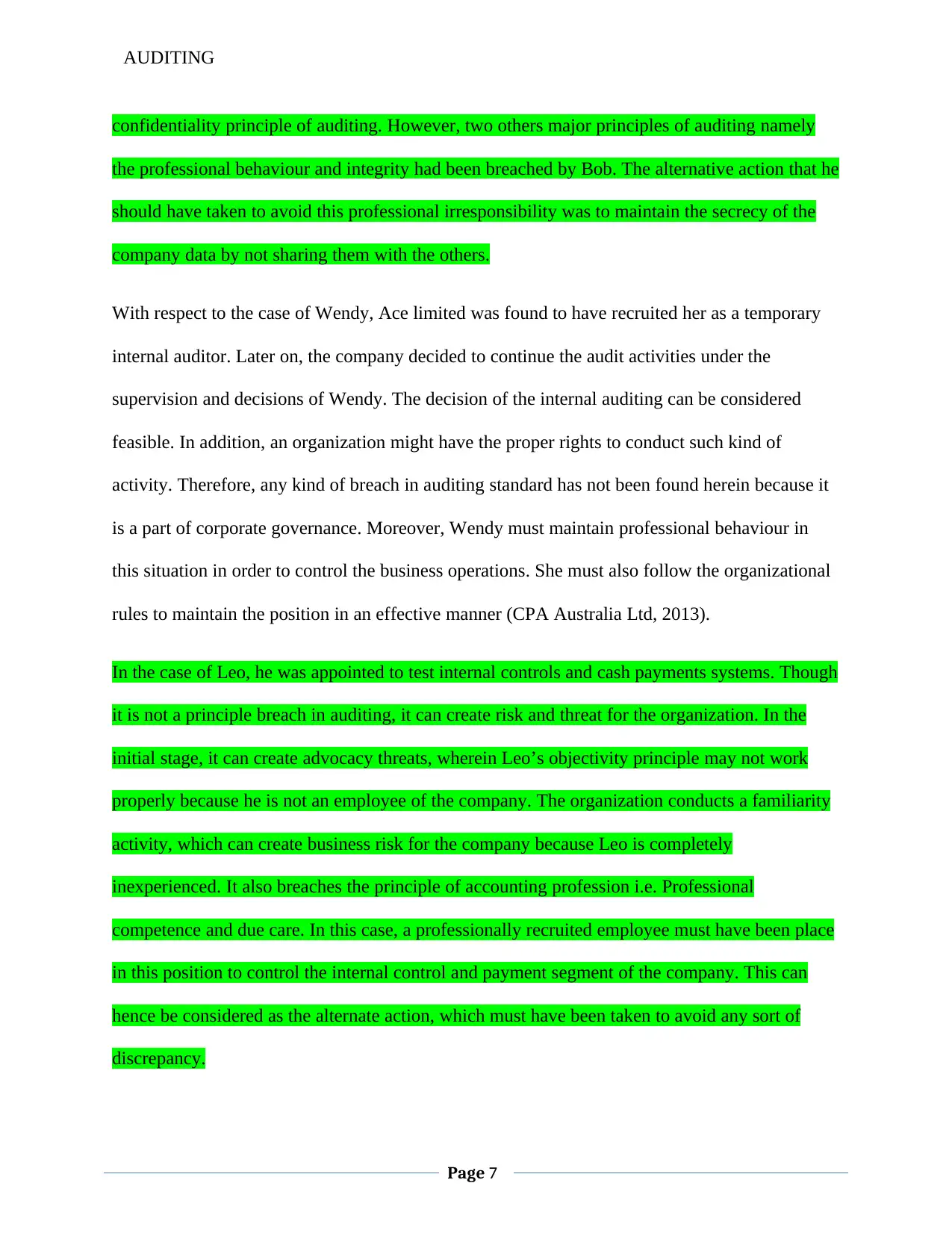
AUDITING
confidentiality principle of auditing. However, two others major principles of auditing namely
the professional behaviour and integrity had been breached by Bob. The alternative action that he
should have taken to avoid this professional irresponsibility was to maintain the secrecy of the
company data by not sharing them with the others.
With respect to the case of Wendy, Ace limited was found to have recruited her as a temporary
internal auditor. Later on, the company decided to continue the audit activities under the
supervision and decisions of Wendy. The decision of the internal auditing can be considered
feasible. In addition, an organization might have the proper rights to conduct such kind of
activity. Therefore, any kind of breach in auditing standard has not been found herein because it
is a part of corporate governance. Moreover, Wendy must maintain professional behaviour in
this situation in order to control the business operations. She must also follow the organizational
rules to maintain the position in an effective manner (CPA Australia Ltd, 2013).
In the case of Leo, he was appointed to test internal controls and cash payments systems. Though
it is not a principle breach in auditing, it can create risk and threat for the organization. In the
initial stage, it can create advocacy threats, wherein Leo’s objectivity principle may not work
properly because he is not an employee of the company. The organization conducts a familiarity
activity, which can create business risk for the company because Leo is completely
inexperienced. It also breaches the principle of accounting profession i.e. Professional
competence and due care. In this case, a professionally recruited employee must have been place
in this position to control the internal control and payment segment of the company. This can
hence be considered as the alternate action, which must have been taken to avoid any sort of
discrepancy.
Page 7
confidentiality principle of auditing. However, two others major principles of auditing namely
the professional behaviour and integrity had been breached by Bob. The alternative action that he
should have taken to avoid this professional irresponsibility was to maintain the secrecy of the
company data by not sharing them with the others.
With respect to the case of Wendy, Ace limited was found to have recruited her as a temporary
internal auditor. Later on, the company decided to continue the audit activities under the
supervision and decisions of Wendy. The decision of the internal auditing can be considered
feasible. In addition, an organization might have the proper rights to conduct such kind of
activity. Therefore, any kind of breach in auditing standard has not been found herein because it
is a part of corporate governance. Moreover, Wendy must maintain professional behaviour in
this situation in order to control the business operations. She must also follow the organizational
rules to maintain the position in an effective manner (CPA Australia Ltd, 2013).
In the case of Leo, he was appointed to test internal controls and cash payments systems. Though
it is not a principle breach in auditing, it can create risk and threat for the organization. In the
initial stage, it can create advocacy threats, wherein Leo’s objectivity principle may not work
properly because he is not an employee of the company. The organization conducts a familiarity
activity, which can create business risk for the company because Leo is completely
inexperienced. It also breaches the principle of accounting profession i.e. Professional
competence and due care. In this case, a professionally recruited employee must have been place
in this position to control the internal control and payment segment of the company. This can
hence be considered as the alternate action, which must have been taken to avoid any sort of
discrepancy.
Page 7
Paraphrase This Document
Need a fresh take? Get an instant paraphrase of this document with our AI Paraphraser
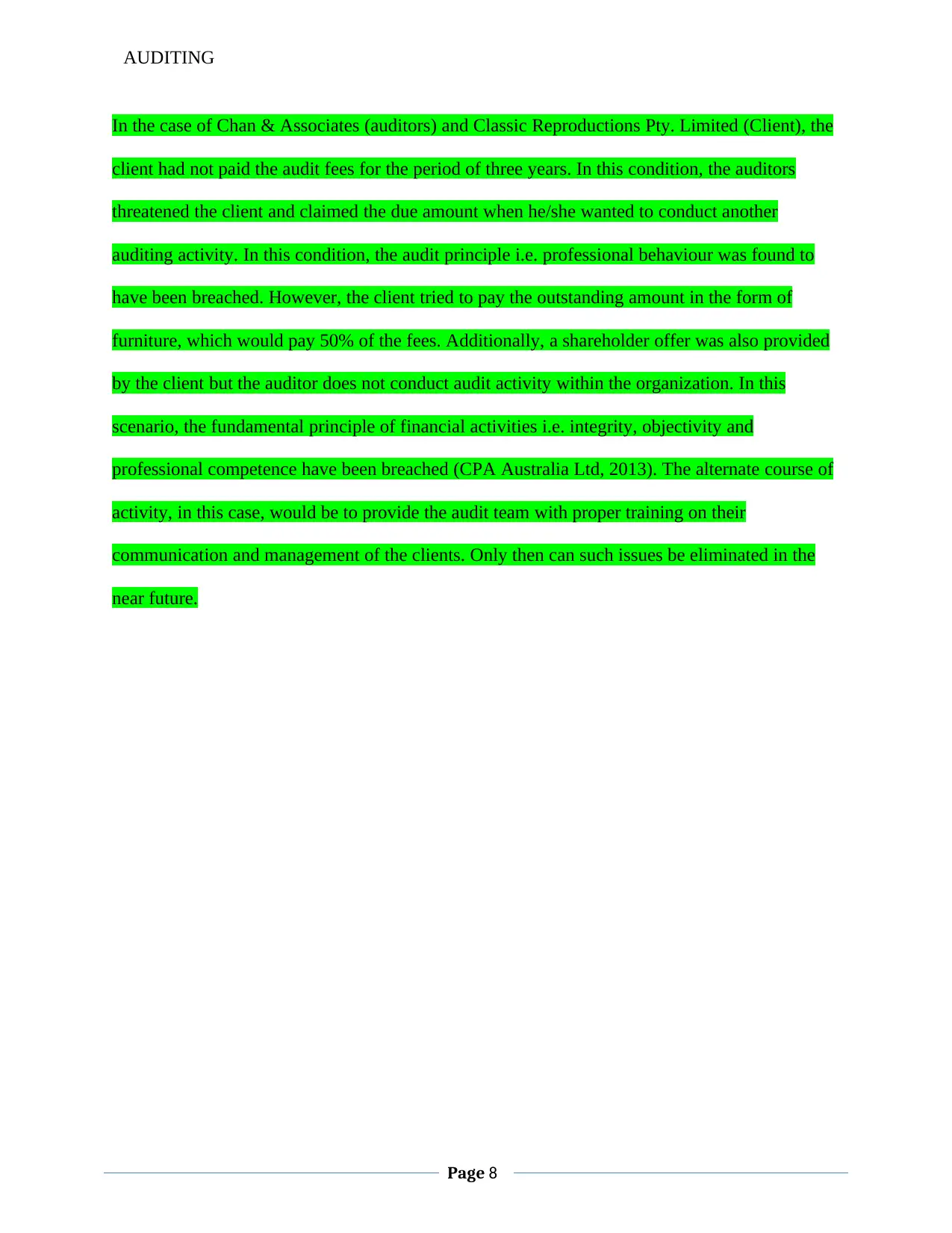
AUDITING
In the case of Chan & Associates (auditors) and Classic Reproductions Pty. Limited (Client), the
client had not paid the audit fees for the period of three years. In this condition, the auditors
threatened the client and claimed the due amount when he/she wanted to conduct another
auditing activity. In this condition, the audit principle i.e. professional behaviour was found to
have been breached. However, the client tried to pay the outstanding amount in the form of
furniture, which would pay 50% of the fees. Additionally, a shareholder offer was also provided
by the client but the auditor does not conduct audit activity within the organization. In this
scenario, the fundamental principle of financial activities i.e. integrity, objectivity and
professional competence have been breached (CPA Australia Ltd, 2013). The alternate course of
activity, in this case, would be to provide the audit team with proper training on their
communication and management of the clients. Only then can such issues be eliminated in the
near future.
Page 8
In the case of Chan & Associates (auditors) and Classic Reproductions Pty. Limited (Client), the
client had not paid the audit fees for the period of three years. In this condition, the auditors
threatened the client and claimed the due amount when he/she wanted to conduct another
auditing activity. In this condition, the audit principle i.e. professional behaviour was found to
have been breached. However, the client tried to pay the outstanding amount in the form of
furniture, which would pay 50% of the fees. Additionally, a shareholder offer was also provided
by the client but the auditor does not conduct audit activity within the organization. In this
scenario, the fundamental principle of financial activities i.e. integrity, objectivity and
professional competence have been breached (CPA Australia Ltd, 2013). The alternate course of
activity, in this case, would be to provide the audit team with proper training on their
communication and management of the clients. Only then can such issues be eliminated in the
near future.
Page 8
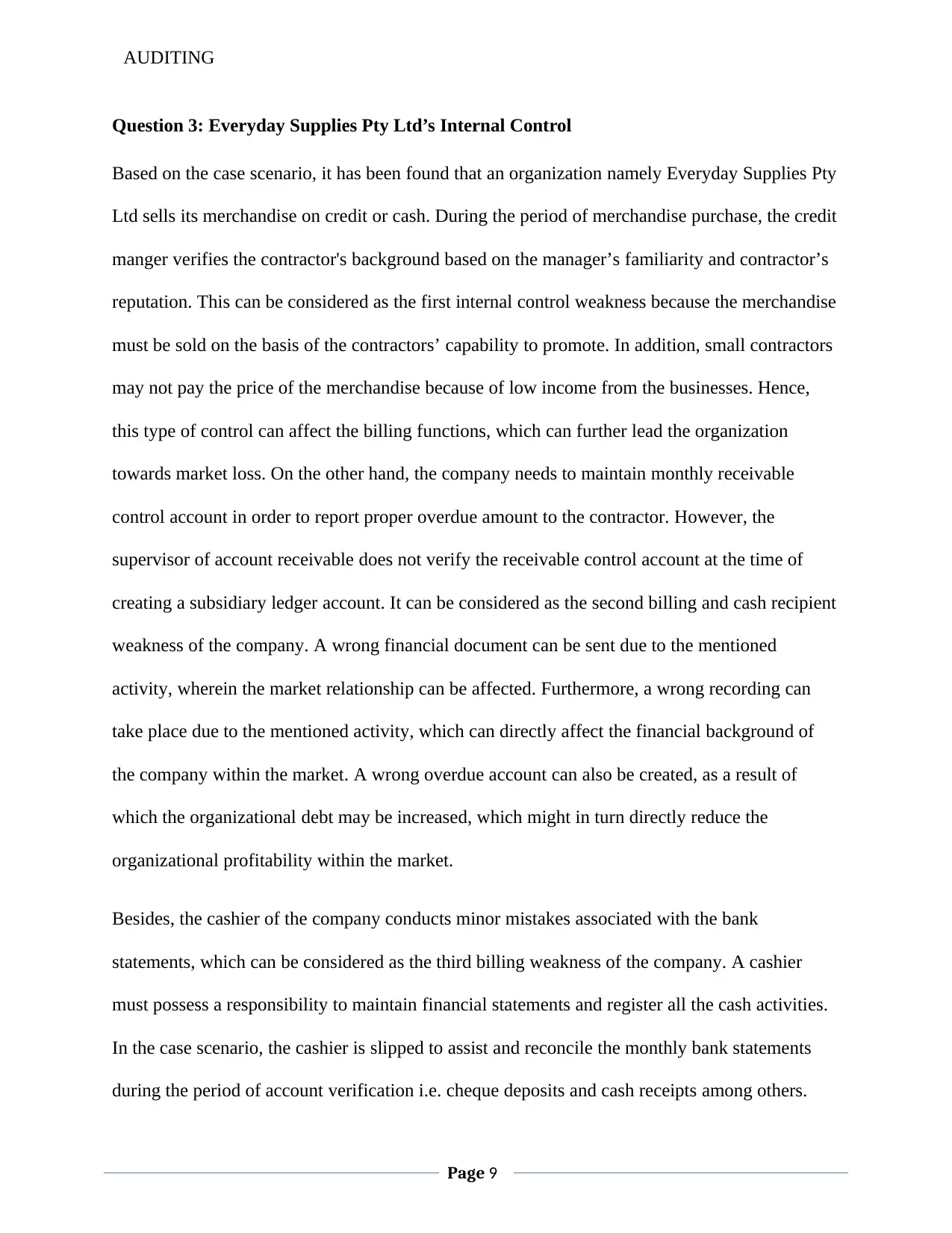
AUDITING
Question 3: Everyday Supplies Pty Ltd’s Internal Control
Based on the case scenario, it has been found that an organization namely Everyday Supplies Pty
Ltd sells its merchandise on credit or cash. During the period of merchandise purchase, the credit
manger verifies the contractor's background based on the manager’s familiarity and contractor’s
reputation. This can be considered as the first internal control weakness because the merchandise
must be sold on the basis of the contractors’ capability to promote. In addition, small contractors
may not pay the price of the merchandise because of low income from the businesses. Hence,
this type of control can affect the billing functions, which can further lead the organization
towards market loss. On the other hand, the company needs to maintain monthly receivable
control account in order to report proper overdue amount to the contractor. However, the
supervisor of account receivable does not verify the receivable control account at the time of
creating a subsidiary ledger account. It can be considered as the second billing and cash recipient
weakness of the company. A wrong financial document can be sent due to the mentioned
activity, wherein the market relationship can be affected. Furthermore, a wrong recording can
take place due to the mentioned activity, which can directly affect the financial background of
the company within the market. A wrong overdue account can also be created, as a result of
which the organizational debt may be increased, which might in turn directly reduce the
organizational profitability within the market.
Besides, the cashier of the company conducts minor mistakes associated with the bank
statements, which can be considered as the third billing weakness of the company. A cashier
must possess a responsibility to maintain financial statements and register all the cash activities.
In the case scenario, the cashier is slipped to assist and reconcile the monthly bank statements
during the period of account verification i.e. cheque deposits and cash receipts among others.
Page 9
Question 3: Everyday Supplies Pty Ltd’s Internal Control
Based on the case scenario, it has been found that an organization namely Everyday Supplies Pty
Ltd sells its merchandise on credit or cash. During the period of merchandise purchase, the credit
manger verifies the contractor's background based on the manager’s familiarity and contractor’s
reputation. This can be considered as the first internal control weakness because the merchandise
must be sold on the basis of the contractors’ capability to promote. In addition, small contractors
may not pay the price of the merchandise because of low income from the businesses. Hence,
this type of control can affect the billing functions, which can further lead the organization
towards market loss. On the other hand, the company needs to maintain monthly receivable
control account in order to report proper overdue amount to the contractor. However, the
supervisor of account receivable does not verify the receivable control account at the time of
creating a subsidiary ledger account. It can be considered as the second billing and cash recipient
weakness of the company. A wrong financial document can be sent due to the mentioned
activity, wherein the market relationship can be affected. Furthermore, a wrong recording can
take place due to the mentioned activity, which can directly affect the financial background of
the company within the market. A wrong overdue account can also be created, as a result of
which the organizational debt may be increased, which might in turn directly reduce the
organizational profitability within the market.
Besides, the cashier of the company conducts minor mistakes associated with the bank
statements, which can be considered as the third billing weakness of the company. A cashier
must possess a responsibility to maintain financial statements and register all the cash activities.
In the case scenario, the cashier is slipped to assist and reconcile the monthly bank statements
during the period of account verification i.e. cheque deposits and cash receipts among others.
Page 9
⊘ This is a preview!⊘
Do you want full access?
Subscribe today to unlock all pages.

Trusted by 1+ million students worldwide
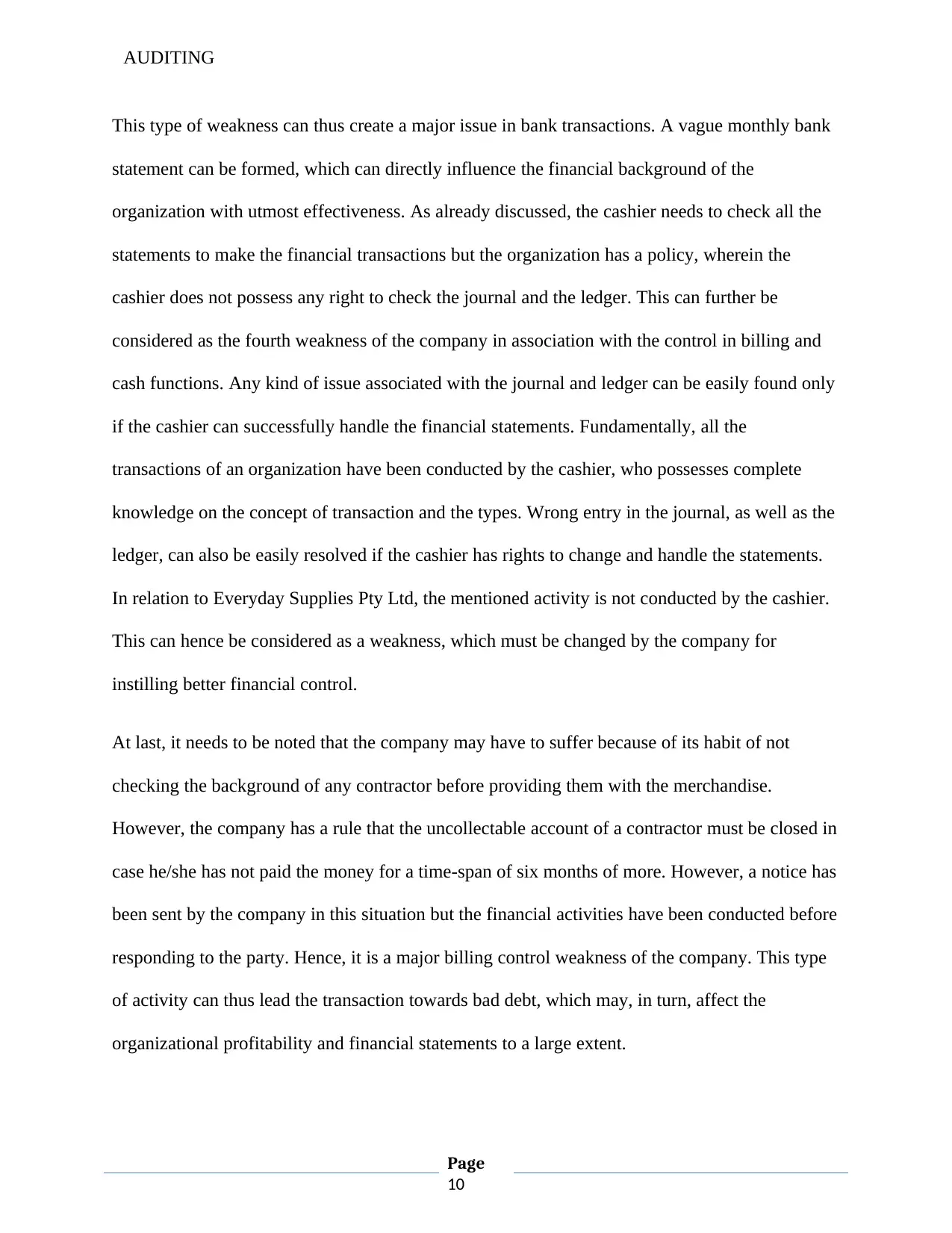
AUDITING
This type of weakness can thus create a major issue in bank transactions. A vague monthly bank
statement can be formed, which can directly influence the financial background of the
organization with utmost effectiveness. As already discussed, the cashier needs to check all the
statements to make the financial transactions but the organization has a policy, wherein the
cashier does not possess any right to check the journal and the ledger. This can further be
considered as the fourth weakness of the company in association with the control in billing and
cash functions. Any kind of issue associated with the journal and ledger can be easily found only
if the cashier can successfully handle the financial statements. Fundamentally, all the
transactions of an organization have been conducted by the cashier, who possesses complete
knowledge on the concept of transaction and the types. Wrong entry in the journal, as well as the
ledger, can also be easily resolved if the cashier has rights to change and handle the statements.
In relation to Everyday Supplies Pty Ltd, the mentioned activity is not conducted by the cashier.
This can hence be considered as a weakness, which must be changed by the company for
instilling better financial control.
At last, it needs to be noted that the company may have to suffer because of its habit of not
checking the background of any contractor before providing them with the merchandise.
However, the company has a rule that the uncollectable account of a contractor must be closed in
case he/she has not paid the money for a time-span of six months of more. However, a notice has
been sent by the company in this situation but the financial activities have been conducted before
responding to the party. Hence, it is a major billing control weakness of the company. This type
of activity can thus lead the transaction towards bad debt, which may, in turn, affect the
organizational profitability and financial statements to a large extent.
Page
10
This type of weakness can thus create a major issue in bank transactions. A vague monthly bank
statement can be formed, which can directly influence the financial background of the
organization with utmost effectiveness. As already discussed, the cashier needs to check all the
statements to make the financial transactions but the organization has a policy, wherein the
cashier does not possess any right to check the journal and the ledger. This can further be
considered as the fourth weakness of the company in association with the control in billing and
cash functions. Any kind of issue associated with the journal and ledger can be easily found only
if the cashier can successfully handle the financial statements. Fundamentally, all the
transactions of an organization have been conducted by the cashier, who possesses complete
knowledge on the concept of transaction and the types. Wrong entry in the journal, as well as the
ledger, can also be easily resolved if the cashier has rights to change and handle the statements.
In relation to Everyday Supplies Pty Ltd, the mentioned activity is not conducted by the cashier.
This can hence be considered as a weakness, which must be changed by the company for
instilling better financial control.
At last, it needs to be noted that the company may have to suffer because of its habit of not
checking the background of any contractor before providing them with the merchandise.
However, the company has a rule that the uncollectable account of a contractor must be closed in
case he/she has not paid the money for a time-span of six months of more. However, a notice has
been sent by the company in this situation but the financial activities have been conducted before
responding to the party. Hence, it is a major billing control weakness of the company. This type
of activity can thus lead the transaction towards bad debt, which may, in turn, affect the
organizational profitability and financial statements to a large extent.
Page
10
Paraphrase This Document
Need a fresh take? Get an instant paraphrase of this document with our AI Paraphraser
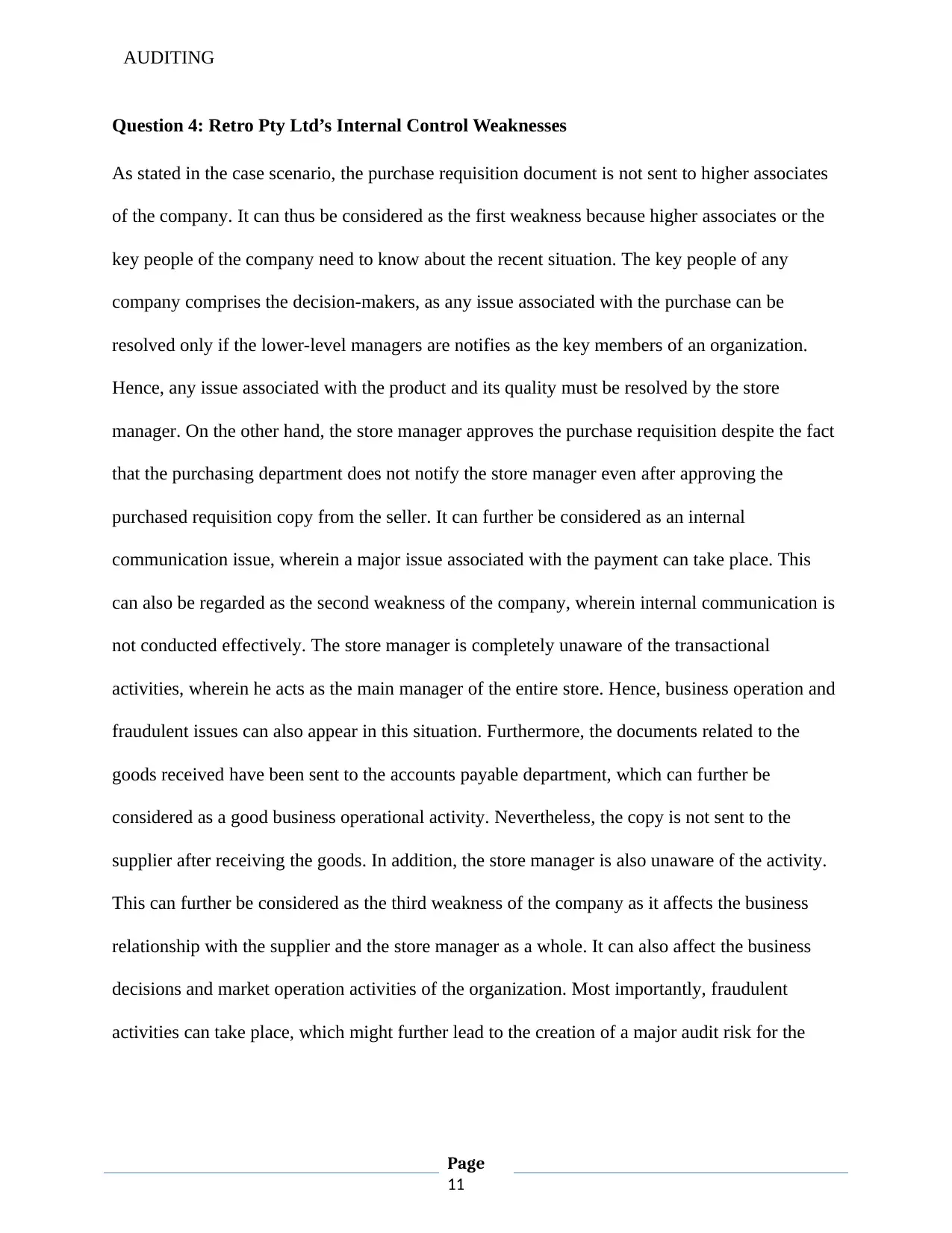
AUDITING
Question 4: Retro Pty Ltd’s Internal Control Weaknesses
As stated in the case scenario, the purchase requisition document is not sent to higher associates
of the company. It can thus be considered as the first weakness because higher associates or the
key people of the company need to know about the recent situation. The key people of any
company comprises the decision-makers, as any issue associated with the purchase can be
resolved only if the lower-level managers are notifies as the key members of an organization.
Hence, any issue associated with the product and its quality must be resolved by the store
manager. On the other hand, the store manager approves the purchase requisition despite the fact
that the purchasing department does not notify the store manager even after approving the
purchased requisition copy from the seller. It can further be considered as an internal
communication issue, wherein a major issue associated with the payment can take place. This
can also be regarded as the second weakness of the company, wherein internal communication is
not conducted effectively. The store manager is completely unaware of the transactional
activities, wherein he acts as the main manager of the entire store. Hence, business operation and
fraudulent issues can also appear in this situation. Furthermore, the documents related to the
goods received have been sent to the accounts payable department, which can further be
considered as a good business operational activity. Nevertheless, the copy is not sent to the
supplier after receiving the goods. In addition, the store manager is also unaware of the activity.
This can further be considered as the third weakness of the company as it affects the business
relationship with the supplier and the store manager as a whole. It can also affect the business
decisions and market operation activities of the organization. Most importantly, fraudulent
activities can take place, which might further lead to the creation of a major audit risk for the
Page
11
Question 4: Retro Pty Ltd’s Internal Control Weaknesses
As stated in the case scenario, the purchase requisition document is not sent to higher associates
of the company. It can thus be considered as the first weakness because higher associates or the
key people of the company need to know about the recent situation. The key people of any
company comprises the decision-makers, as any issue associated with the purchase can be
resolved only if the lower-level managers are notifies as the key members of an organization.
Hence, any issue associated with the product and its quality must be resolved by the store
manager. On the other hand, the store manager approves the purchase requisition despite the fact
that the purchasing department does not notify the store manager even after approving the
purchased requisition copy from the seller. It can further be considered as an internal
communication issue, wherein a major issue associated with the payment can take place. This
can also be regarded as the second weakness of the company, wherein internal communication is
not conducted effectively. The store manager is completely unaware of the transactional
activities, wherein he acts as the main manager of the entire store. Hence, business operation and
fraudulent issues can also appear in this situation. Furthermore, the documents related to the
goods received have been sent to the accounts payable department, which can further be
considered as a good business operational activity. Nevertheless, the copy is not sent to the
supplier after receiving the goods. In addition, the store manager is also unaware of the activity.
This can further be considered as the third weakness of the company as it affects the business
relationship with the supplier and the store manager as a whole. It can also affect the business
decisions and market operation activities of the organization. Most importantly, fraudulent
activities can take place, which might further lead to the creation of a major audit risk for the
Page
11
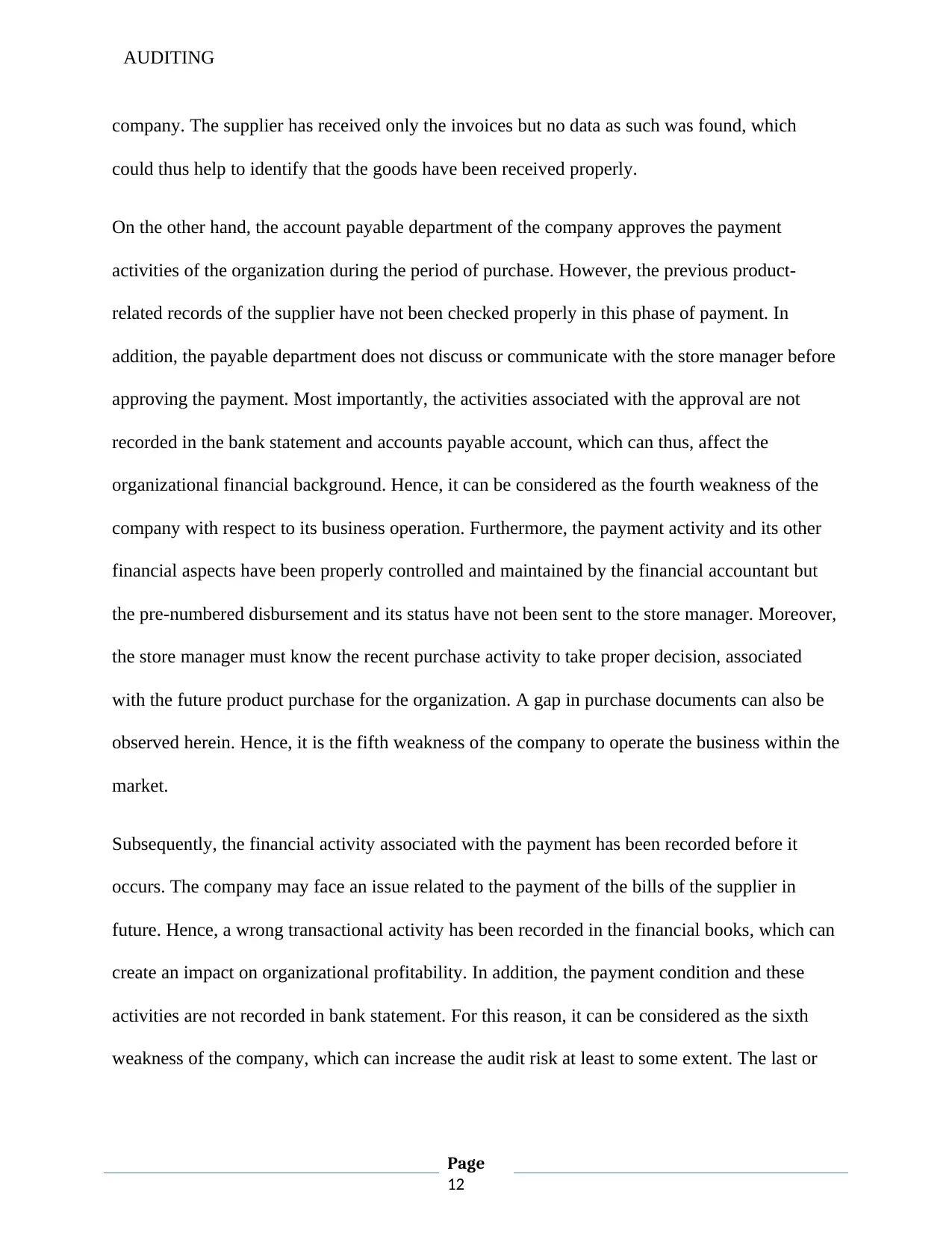
AUDITING
company. The supplier has received only the invoices but no data as such was found, which
could thus help to identify that the goods have been received properly.
On the other hand, the account payable department of the company approves the payment
activities of the organization during the period of purchase. However, the previous product-
related records of the supplier have not been checked properly in this phase of payment. In
addition, the payable department does not discuss or communicate with the store manager before
approving the payment. Most importantly, the activities associated with the approval are not
recorded in the bank statement and accounts payable account, which can thus, affect the
organizational financial background. Hence, it can be considered as the fourth weakness of the
company with respect to its business operation. Furthermore, the payment activity and its other
financial aspects have been properly controlled and maintained by the financial accountant but
the pre-numbered disbursement and its status have not been sent to the store manager. Moreover,
the store manager must know the recent purchase activity to take proper decision, associated
with the future product purchase for the organization. A gap in purchase documents can also be
observed herein. Hence, it is the fifth weakness of the company to operate the business within the
market.
Subsequently, the financial activity associated with the payment has been recorded before it
occurs. The company may face an issue related to the payment of the bills of the supplier in
future. Hence, a wrong transactional activity has been recorded in the financial books, which can
create an impact on organizational profitability. In addition, the payment condition and these
activities are not recorded in bank statement. For this reason, it can be considered as the sixth
weakness of the company, which can increase the audit risk at least to some extent. The last or
Page
12
company. The supplier has received only the invoices but no data as such was found, which
could thus help to identify that the goods have been received properly.
On the other hand, the account payable department of the company approves the payment
activities of the organization during the period of purchase. However, the previous product-
related records of the supplier have not been checked properly in this phase of payment. In
addition, the payable department does not discuss or communicate with the store manager before
approving the payment. Most importantly, the activities associated with the approval are not
recorded in the bank statement and accounts payable account, which can thus, affect the
organizational financial background. Hence, it can be considered as the fourth weakness of the
company with respect to its business operation. Furthermore, the payment activity and its other
financial aspects have been properly controlled and maintained by the financial accountant but
the pre-numbered disbursement and its status have not been sent to the store manager. Moreover,
the store manager must know the recent purchase activity to take proper decision, associated
with the future product purchase for the organization. A gap in purchase documents can also be
observed herein. Hence, it is the fifth weakness of the company to operate the business within the
market.
Subsequently, the financial activity associated with the payment has been recorded before it
occurs. The company may face an issue related to the payment of the bills of the supplier in
future. Hence, a wrong transactional activity has been recorded in the financial books, which can
create an impact on organizational profitability. In addition, the payment condition and these
activities are not recorded in bank statement. For this reason, it can be considered as the sixth
weakness of the company, which can increase the audit risk at least to some extent. The last or
Page
12
⊘ This is a preview!⊘
Do you want full access?
Subscribe today to unlock all pages.

Trusted by 1+ million students worldwide
1 out of 16
Related Documents
Your All-in-One AI-Powered Toolkit for Academic Success.
+13062052269
info@desklib.com
Available 24*7 on WhatsApp / Email
![[object Object]](/_next/static/media/star-bottom.7253800d.svg)
Unlock your academic potential
Copyright © 2020–2025 A2Z Services. All Rights Reserved. Developed and managed by ZUCOL.




